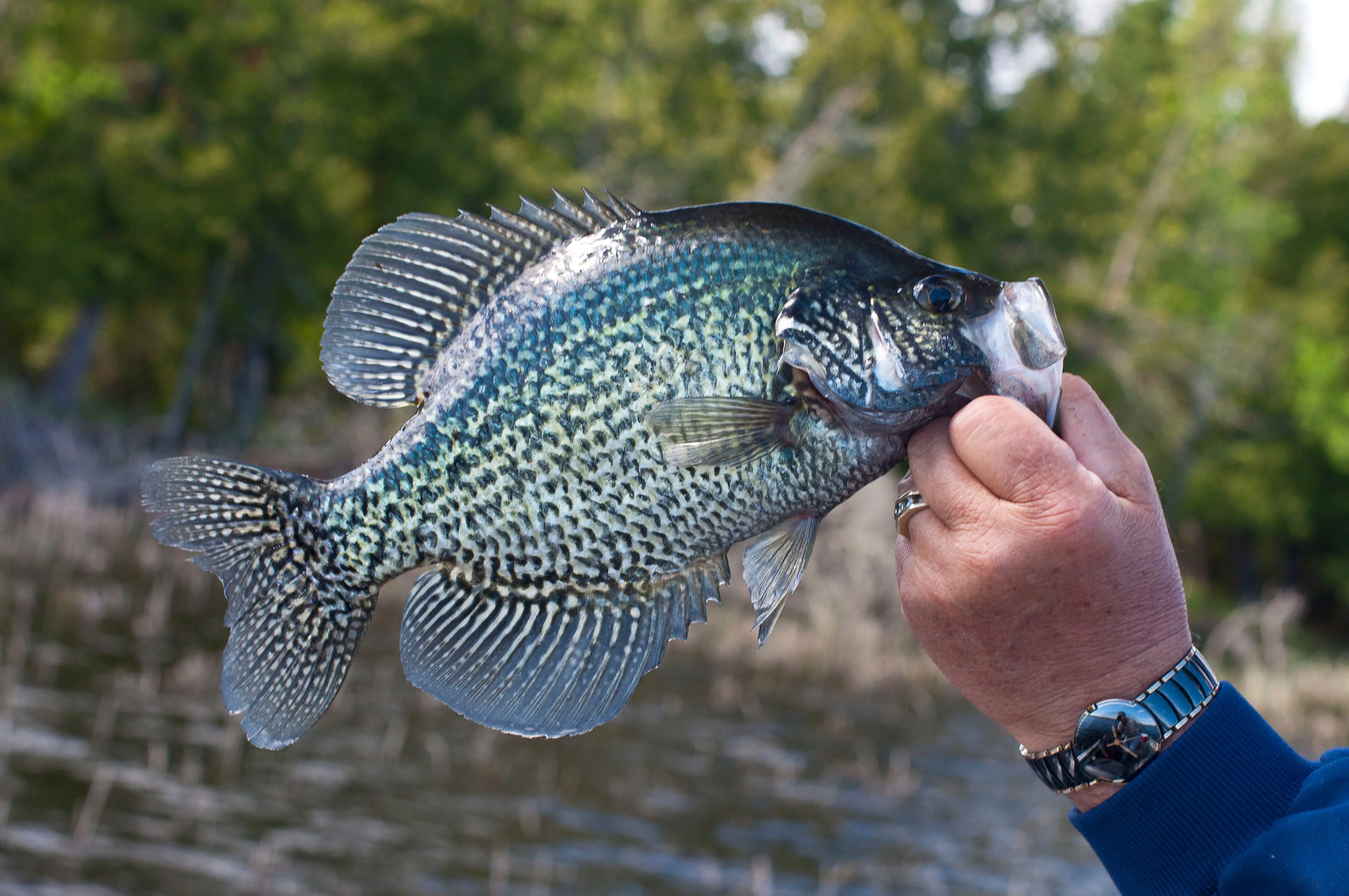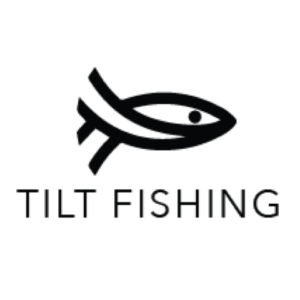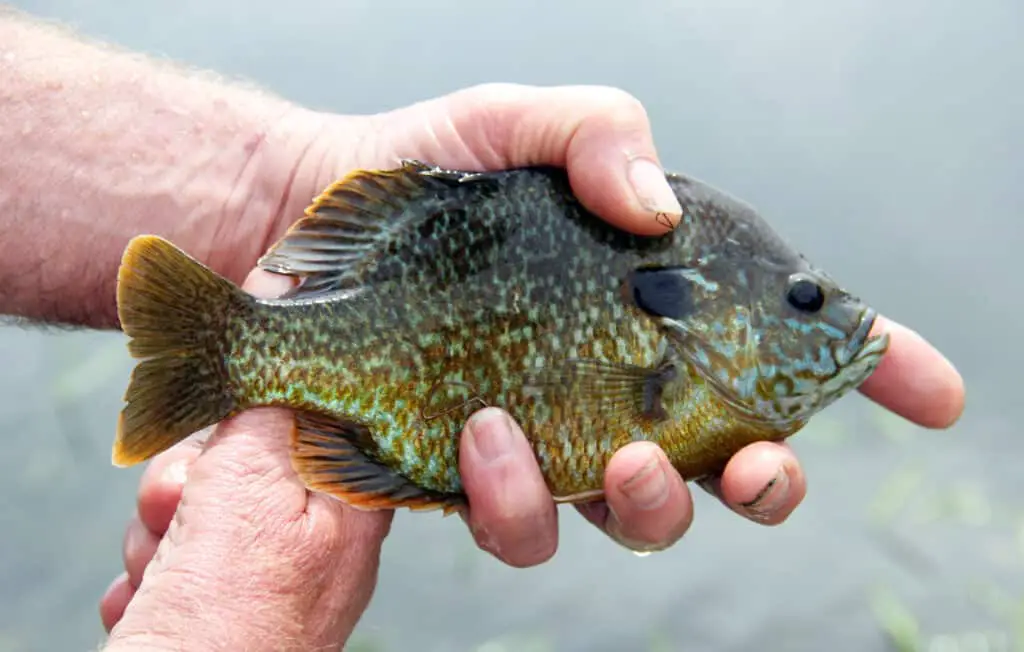Fishing line is one of the most fundamental and important pieces of fishing equipment for any angler regardless of their targeted species. The right fishing line allows anglers to effectively fish different baits and lures and is their direct connection to the fish. Having the right type and size of line is extremely important and can ultimately make a huge difference.
If you are new to pan fishing or are trying out a new lure or technique you might be wondering what line type and weight you should be using when fishing for panfish. This is an important question, and the right answer may vary depending upon a few different factors.
When fishing for panfish the best fishing line to use is 4-6lb monofilament or fluorocarbon. This line gives anglers the necessary strength, sensitivity and casting ability needed for when targeting panfish. If you are after larger sized panfish or are fishing around cover 6-8lb is the ideal line weight. When fishing in open water and for normal sized panfish, I recommend using 4lb monofilament or fluorocarbon line.
With that being said each pan fishing method, technique, and situation might call for a slightly different line size and type. If you would like to learn more about how to choose the right fishing line for crappie, bluegill, perch and other panfish, please continue reading below.
Fishing Line for Panfish
If you have ever looked online or at your local sporting goods store for fishing line, you’ll notice that there are a ton of different line options you can choose from. With so many choices in can be difficult to know which line you should use when targeting panfish.
After all there are a lot of things to consider, and the right line size may be vary depending upon the body of water you are fishing, the caliber of the fish, and the cover or structure on the water.
To help make sure you select and fish with the right line size on your pan fishing adventures, I’ve put together the following guide.
How to Choose Fishing Line for Panfish
Using the right type and line strength is really important when pan fishing and can be the difference between catching and not catching any fish.
As I mentioned previously the right type and pound test to use for panfish depends upon several factors including the caliber of fish you are targeting, type of lures you’re using, and the cover and water you are fishing at.
Here is exactly what you need to know about the different line types, how to choose the right line, the importance of pound test, and which line you should use for each pan fishing rig, technique and species.
Line Strength
The strength of a fishing line is measured by how many pounds of force it takes to break the line. The larger the pound test of the line means the more force it can take without breaking.
The downside to larger line is that has a bigger in diameter, is more visible and tends to make baits look unnatural.
On the other hand, if you choose fishing line that has too small of pound test you can easily break off and loose fish. That’s why having the right balance is key.
Before you purchase fishing line consider what size/weight of the lures you are using, caliber of fish you are catching. When pan fishing you are using light tackle, lures and the fish aren’t very big. For this reason, it’s best to use lighter line. I like to use 4lb test in open water and 6-8lb test when targeting trophies or when around heavy cover or structure.
Fishing Line Type
There are three main types of fishing line that anglers will use when fishing for panfish: monofilament, fluorocarbon, and braid. Each line has its own strengths and weaknesses.
When fishing for panfish like crappie, bluegill or perch I recommend keeping things simple and fishing with either 4-6lb fluorocarbon or monofilament line. Both are great options for almost any panfishing rig or technique and they are widely available.
If you really want to dial in what type of line you should use here is some more in-depth information about the different line types and the pro’s and cons of each.
Fluorocarbon
The fishing line I probably use the most is fluorocarbon. It has a smaller diameter when compared to monofilament, has less stretch, it sinks, and its lot more sensitive.
Fluorocarbon is also nearly invisible in the water which makes it a great choice in clear water. Fluorocarbon is always my preferred choice for most pan fishing situations the only downside is it’s a little more expensive than monofilament.
Monofilament
Monofilament has been the original fishing line material and has been around for what seems like forever. It has the largest diameter when compared to the other fishing line types and also has the most stretch. Monofilament is also a floating line and is pretty good at abrasion resistance.
Monofilament is a great option when you are pan fishing with some type of live bait. Its affordable, easy to find and works great for these pan fishing applications.
Braid
Braided fishing line gives you the ultimate strength with zero stretch and has a really small diameter given its strength. This combination makes it great as a main line and when fishing around grass and heavy cover.
It’s also highly visible in the water and can shy away fish. For this reason, I’d recommend using braid as a main line and paring it with either fluorocarbon or monofilament leader. Unless you are fishing in murky water where the fish aren’t going to be line shy.
Braid isn’t as popular for panfishing, but a lot of anglers have enjoyed using it when fishing in murky water and around heavy structure. It’s more sensitive, has a thin diameter and is great for pulling fish out of thick cover.
With all that being said, I’ve put together the following pan fishing line guide that will help you select the right line size each fishing scenario.
Pan Fishing Line Guide
| Fishing Situation | Line Size | Line Type |
| Clear Water or Smaller Fish | 2lb | Fluorocarbon or Monofilament |
| Open Water | 4lb. | Fluorocarbon or Monofilament |
| Sparse Cover | 4-6lb. | Fluorocarbon or Monofilament |
| Heavy Cover | 6-8lb. | Fluorocarbon or Monofilament |
| Trophy Panfish | 6-8lb. | Fluorocarbon or Monofilament |
| Heavy Cover | 8lb | Braid + Fluro or Mono Leader |
Check out this article for more guidance on how to choose the right fishing line for each species and fishing technique: What Pound Test of Fishing Line to Use [Complete Guide]
Best Line for Panfish
When anglers refer to panfish they are typically talking about a variety of small fish of several species that are abundant, good tasting and can fit into a frying pan. The most common panfish are crappie, bluegill, and perch but there are also other freshwater and saltwater panfish as well.
Due to their size, fight and the techniques, rigs and baits that are used to catch panfish light tackle, equipment and line is ideal when targeting these fish.
For this reason, most anglers targeting panfish will use light monofilament or fluorocarbon line (2-6lb test) for most applications. In my opinion the best overall line to use when fishing for panfish 6lb fluorocarbon. It’s a versatile line that can be fished in clear open water as well as around cover.
However, the ideal line might depend on the size and type of panfish you are targeting. Here is the type of line I recommend for each type of panfish.

Best Line for Crapppie
Fishing for crappie is very popular in the United States and they are known for being a great tasting sport fish. Anglers will catch them using a variety of different methods, including bait fishing, artificial lures and soft plastic baits.
Factoring their size, strength and where they are commonly located the best line to use for crappie is 4-6lb monofilament or fluorocarbon line. If fishing around cover, heavier line like 6lb test is ideal. When fishing in open or clear water conditions lighter line like 4lb will help you catch more fish.
Best Line for Bluegill
Bluegill are one of the more popular panfish to target and many anglers find them enjoyable to eat. A common size of blue gill is around 7 inches but they can grow up to 16 inches and typically weigh around 1-2 pounds.
They are commonly found in ponds, lakes and streams and like to hang out around tree-shaded shore lines, grass, overhanging structure and submerged vegetation. Anglers will typically target bluegill with live bait like worms or us small lures or jigs. They are also popular to target on a fly rod with small flies.
Due to their size, where they are found and the baits and lures typically used its best to fish with light line. The best line to use for bluegill is 2-6lb fluorocarbon or monofilament. I personally like to use 4lb fluorocarbon. It’s a versatile line strength that can be used for in almost any bluegill fishing situation.
Best Line for Perch
Perch are a very popular sport fish species and known for tasting good and putting up a pretty good fight for their size. Anglers will catch them using a few different methods, including bait fishing, lure fishing and fly fishing.
They can grow up to 20 inches and weight up to 5 lbs or more. However, the most common size anglers will see is 1lb or less with a 2lb perch being a nice fish.
Given their size, fight and where they are found the best line to use when fishing for perch is 4-6lb monofilament or fluorocarbon line. If you are targeting trophy perch or are fishing around heavy cover, I would up my line size to 6-8lb test. If not, 4-6lb test is the ideal line when fishing for perch.
The Top Fishing Lines for Panfish
Now that we have discussed what the right type of line and size you should use when targeting panfish. You might be wondering what are the specific brands and lines are the best.
Here are the best fishing lines that I recommend using when targeting panfish:
Best Panfish Fishing Line
Seaguar Invizx (Fluorocarbon)

My go to fishing line I like to use when fishing for panfish is 6lb Seaguar Invizx. In my opinion it is the perfect line to use for any panfishing situation. It’s super sensitive, clear, and affordable. This line is a great value and is one that I would highly recommend using. I especially like it if i’m fishing with small crankbaits, jigs and other reaction style fishing techniques.
Stren Original (Monofilament)

Another great line option that is very popular among pan fishing anglers is 4-6lb Stren Monofilament. In my experience this line it perfect for when fishing with bait. It’s also extremely affordable and can be easily found online or at an sporting goods store. It can also work great when using jigs, lures in shallow water. The performance and value of this line is hard to beat.
Sufix 832 Advanced Superline (Braid)

If you want a super sensitive fishing line that will allow you to pull fish out of heavy cover than the Suffix Superline Briad is the line for you. This line especially works great when fishing reaction style lures like jigs. It has little to no stretch making hook sets super easy. The only downside is that it is highly visible in the water and won’t be as effective if the fish are line shy. That’s why I recommend pairing this line with a fluorocarbon leader for the ultimate combo.
Other Panfishing Resources
- Not Catching Crappie? Here are 8 Reason’s Why
- When Do Bluegill Spawn?
- Are Crappie Good Eating? Here’s What You Should Know
Panfishing Line Q&A
Is 8 lb. line good for crappie? The heavier the line size the easier it is going to be to land bigger fish and pull them out of grass and structure. The lighter the line the more sensitivity you’ll have and the more fish you will end up catching. For these reason I would not recommend using 8lb test for crappie unless you are targeting trophies or fishing around heavy structure.
What is the best fishing line for panfish? In my experience the best fishing line to use for panfish is 4-6lb monofilament or fluorocarbon line. This line gives anglers the right diameter, strength and sensitivity for almost any panfish.
Is fluorocarbon line good for crappie fishing? Fluorocarbon line is a popluar line to use for pan fishing and is my personal favorite. It’s sensitive and pretty much invisible making ideal for many pan fishing situations.
Bottom Line
Selecting the right type and size of fishing line when fishing for panfish is extremely important and can impact your overall fishing success.
The right pound test of line will allow you to cast further, use certain baits and techniques effectively, and ensure you can land your prized catch.
Before you head out on your next fishing adventure make sure you have selected the right line size for your style of fishing. You’ll have a lot more success and will have a much better experience.

